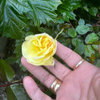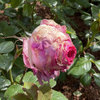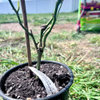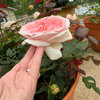Can you give us a report on Japanese Beetles in the Midwest?
Last year my rose garden was so inundated by these pests that from late June until end of August all my rose flowers were consumed. None of them opened. They shredded by linden tree, ate all my peaches, and other plants too. My morale was low about roses this year, but:
I cut down the Linden.
I put down milky spore in Spring 2012.
I put Milky Spore down Spring 2013. I intend to follow up with even more milky spore as the year goes on.
My wife sprayed a Bayer product on the roses intended to make them less attractive to JBs. And of course in the Midwest last year we had a drought, which I read is devastating to JBs. (this year we have had an abundance of rain).
This year, on Infestation Day 1 two weeks ago I had at least 200 JBs on my rose bushes. I removed as many as I could that day by hand, then I decided in addition to all other measures I would spray the living daylights out of the roses early to see if I could keep the JB phernomes from inviting their friends. And for the first week I thought possibly I was both losing while making progress. I had not sprayed for 3 days. Tonight on 32 of my roses I dead headed and picked off only 10 JBs by hand. There were very few on my plants and my roses are still blooming !!!
Is it solely the drought; or is it our additional efforts to control that helped?
What is happening in your neighborhoods? For those out east, does this ever get better? Do natural predators learn how to deal with these guys. In your experience, are nematodes helpful?













dublinbay z6 (KS)
mark_roeder 4B NE IowaOriginal Author
Related Professionals
Barrington Hills Landscape Architects & Landscape Designers · Port Royal Landscape Architects & Landscape Designers · Wheeling Landscape Architects & Landscape Designers · Americus Landscape Contractors · Downey Landscape Contractors · Elmhurst Landscape Contractors · Fort Payne Landscape Contractors · Mount Kisco Landscape Contractors · Red Oak Landscape Contractors · Seminole Landscape Contractors · St. Louis Landscape Contractors · Vacaville Landscape Contractors · Waterford Landscape Contractors · West Haverstraw Landscape Contractors · Wethersfield Landscape Contractorswirosarian_z4b_WI
seil zone 6b MI
Terry Crawford
mark_roeder 4B NE IowaOriginal Author
nippstress - zone 5 Nebraska
jim1961 / Central Pennsylvania / Zone 6
t_bred
Terry Crawford
chicken_woman
veryzer
johnnycabot
jim1961 / Central Pennsylvania / Zone 6
kentstar